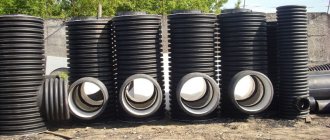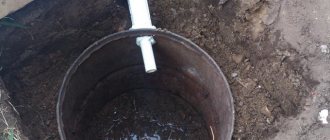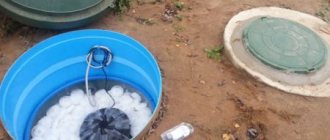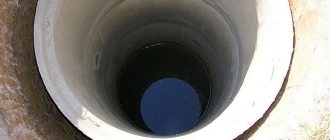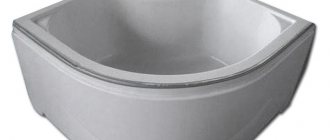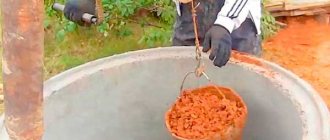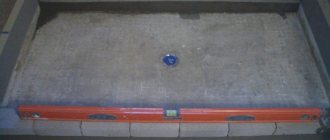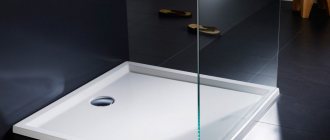Increasingly, shower stalls are being installed in houses/apartments instead of a standard bathtub. This is very convenient and saves space in the bathroom, since the cabin is compact and takes up little space. To collect wastewater after taking a shower, use a tray that is installed with the shower stall, or a drain that is securely installed in the floor. Then the water flows through the drain into the sewerage system through pipes.
This system is very simple, convenient and durable. The main thing is to install the drain correctly so that the water flows freely. It is also important that everything is sealed to avoid flooding. In this article we will tell you how to install a shower drain with your own hands, consider the option of installing it in the floor under tiles, and also give photo and video instructions.
Design features
Depending on the location of installation, ladders can be divided into the following types:
- horizontal;
- vertical.
A horizontal drain is often installed in an apartment located in a multi-story building, since the sewer connection often runs from the side, at a slight angle, draining water into the sewer pipe. Thus, the water will flow to the side, directly into the sewer.
The vertical drain is suitable for owners of private houses and cottages, where the sewage system can run under the floor. They have high throughput.
Shower drain kit
The shower drain kit is as follows:
- Siphon. It consists of a water seal and a dry/mechanical seal. This design serves to block unpleasant odors that may come from the sewer. The dry seal is a float design that reacts to the drying out of the siphon and prevents the entry of foul odor from the drainage pipe. When the water dries out, the float drops and the sash closes. A mechanical shutter is a non-freezing design that is used in an unheated room.
- Decorative lattice. It is installed on the ladder body and rests on its surface. The surface of the grille on the outside is at the same level with the sides of the ladder.
- Drainage ring. If a waterproofing rupture occurs, the ring will allow water to flow back into the drain through the hole located in the ring.
- A steel pressure flange is used to ensure a tight connection between the waterproofing and the body of the shower drain.
- Gangway body.
Shower drain device
Although there are many different types of these products, the basic elements do not differ much. Any ladder consists of:
- Lattices. This is the uppermost part of the ladder device. Only it remains visible after final installation. It has an aesthetic and protective function, preventing large debris from entering the pipeline.
- Perforated metal glass. It is an additional filter for cleaning small elements.
- Rubber seal, which allows you to adjust the installation height of the product.
Shower drain installation - A shutter whose function is to prevent the penetration of sewer odors.
- Ladder bodies, including bends. Thus, the ladder is similar to a funnel, on one side of which there is a flange that secures the pipes, and a single outlet and outlet.
Advice! When choosing a shower drain, you need to consider its height. This will determine how much you need to raise the floor in the bathroom. Additionally, the taller the device, the better its throughput capabilities. The best option is an adjustable ladder that can be adjusted to any screed height.
Equipment selection
Before installation of the drain begins, it is important to choose it correctly. Just before purchasing equipment, pay attention to the following features:
Direction of water drainage.
- Branch diameter. There are often 2 options: Ø 50 mm and Ø 110 mm. It all depends on the diameter of the sewer pipes in the system.
- The height of the ladder will depend on the height of the floor where it will be installed.
If the kit does not include a hydraulic valve, it must be purchased separately. There are two options: a device with a dry shutter or a mechanical one. If the water seal dries out, the unpleasant odor will be blocked by a dry or mechanical seal.
Choosing a location
The location where the ladder will be located must be chosen at the design stage. Why? Because the equipment will be mounted in the floor. Therefore, it needs to be prepared in advance. A pipe is installed in it, which will be connected to the sewer. It is important to make a slope of at least 3º so that water flows through the pipe without obstacles. Then a recess is made into which the ladder will be installed. But there are two development options:
- When a shower is installed during the construction of a house, problems should not arise. Indeed, in this case, the project includes the installation of a sewerage system, with connections for all means of communication. Therefore, the floor and screed are made in such a way as to ensure the correct angle for draining water from the drain and a drain pipe is installed.
- If the building has already been built, the question arises, where exactly to drain? You can create a stable deck by raising the floor and draining it into the sewer system, or you can remove the screed and create a new drain.
The floor covering should have a slight slope directly towards the ladder. Then the water will quickly go down the drain without accumulating in the shower.
Angle of inclination
You can place the ladder in the following places:
- In the center, where the slope of the floor should be on all sides towards the drain.
- In a corner when a triangular shaped ladder is used. Then the slope of the floor should be on all sides and directed towards the drain.
- Along the edge where the slope will be directed only in one direction. In this case, a slotted drain is used.
What is a shower drain in a tiled floor: what is it used for?
The design of a shower drain can be made from different types of materials. Plastic or metal is suitable for this. This device ensures the accumulation and removal of water from the shower floor. The product is characterized by simplicity of design, convenience and low cost.
Design of the drainage mechanism
The structure of this product assumes the presence of the following elements:
- funnels for receiving water with a flange where the liquid moves. The outlet pipe is located at the bottom of the product;
- the flange is used to fix the membrane with waterproofing;
- a removable grid is required to retain large particles;
- a siphon that helps create a water seal in the drain mechanism. Such a device protects the room from foul odors.
Drainage components and cross-section of the product
In addition to removing water and collecting it, a shower drain in the floor under the tiles holds debris to prevent blockages, and also prevents the passage of any odors.
Materials
Once you have decided on the choice of equipment and location, we proceed to installation. All work can be done with your own hands without the help of specialists. To work you need to prepare:
- sifted sand;
- cement;
- material for thermal and sound insulation (foam is most often chosen);
- waterproofing membrane;
- adhesive composition or mastic;
- anti-slip tiles or mosaics from which the floor will be made.
Installation
If you are doing work in a constructed building, the first step is to remove the top layer of the floor. The tile or other covering is torn down to the base. Do this until you reach the concrete floor. After this it needs to be cleaned.
Foam plastic is laid on the cleaned concrete. Its thickness should be at least 4 cm, and it itself should be quite rigid. Do not forget that you need to ensure that the floor level slopes towards the place where the water will drain. To do this, use a level, checking each installation step. You also need to make a cutout in the foam for the sewer pipe and drain.
In the place you have chosen and where the sewer pipe is connected, install a shower drain. It must be connected to the sewer drain. It is important to observe the slope, which will be directed towards the riser. To install the device at the required level, use improvised means or special adjustable legs. Using a level, check that the grate is level with the floor.
Filling the ladder with screed
Then everything is filled with sand-cement mortar. This way the ladder will be fixed. In order for the screed to adhere well to the surface of the device, it must be degreased with acetone or solvent. The screed layer is applied taking into account the slope necessary to direct the water to the drainage point. Each installation step is checked with a level.
To ensure the tightness of the drain, after the screed has dried, it must be carefully sealed. You can use silicone sealant for this. Since there will always be water on the shower floor, it should not let it through. Water should only drain through the drain.
In order not to worry about sealing and calculating the desired angle, you can buy a special acrylic or enamel tray. It can be easily connected to the ladder without any finishing work.
Waterproofing
Now you need to provide waterproofing. To do this, you need to fill the screed with a special waterproofing layer and “drown” the fiberglass seal into it using a special trowel. A layer of waterproofing must be applied to the wall around the perimeter. The fiberglass mesh should be placed so that the canvas 10–15 cm extends along the wall. No need to cut it in the corners. Make a fold and glue it to the wall with waterproofing mixture. Pour the concrete again and make a screed, taking into account the slope towards the ladder.
Types of waterproofing
This is followed by finishing work. It is necessary to apply mastic or adhesive and lay tiles or mosaics. It is important to note that the ladder grating should be located at the same level as the facing. It is very convenient to use mosaic on a mesh as a finishing material, since as you lay it, it can be cut off in the place where the drain is installed. After which all seams must be sealed with moisture-resistant grout.
The tiles are laid on the wall in the same way. Before laying it, it is advisable to make a waterproofing screed to a height of 30–40 cm.
Finished shower tray
All you have to do is wait for it to dry completely. The drain has been installed and will ensure reliable drainage of water into the sewer system. If you have any questions on the topic, please ask them at the end of this article. A specialist working on our website will provide you with advice.
Advantages of a shower with built-in drain
The variety of trays and drains for drainage water is explained by the fact that there is a need for shower stalls - not purchased ones, which are a single prefabricated structure, but stationary ones, without a tray and complex electronic “stuffing”.
The design of the cabin is simple and convenient: a bar with a shower, smoothly opening plastic compartment doors, a non-slip floor covered with ceramic tiles. You can organize such a place for taking water procedures yourself by laying the floor and walls with tiles and correctly connecting communications.
Even without restrictive edges and borders, water does not flow out of the cabin if the floor covering is properly equipped - with a slight slope, ensuring the outflow of water into the drainage device
Why do owners of spacious bathrooms and cramped bathrooms choose this shower option? It has a lot of advantages:
- variety of sizes and configurations;
- possibility of placement in non-standard premises;
- creation of a unique design;
- ease of care and regular cleaning;
- comfortable use of the shower by older people.
One of the technical advantages is the presence of an emergency drain. During force majeure circumstances (water supply failure in your apartment or neighbors upstairs), water will drain through a drain built into the ceramic floor tiles.
